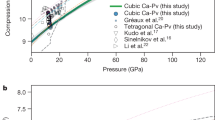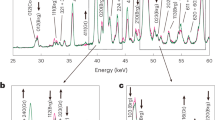Abstract
Constraining the chemical, rheological and electromagnetic properties of the lowermost mantle (D″) is important to understand the formation and dynamics of the Earth's mantle and core. To explain the origin of the variety of characteristics of this layer observed with seismology, a number of theories have been proposed1, including core–mantle interaction, the presence of remnants of subducted material and that D″ is the site of a mineral phase transformation. This final possibility has been rejuvenated by recent evidence for a phase change in MgSiO3 perovskite (thought to be the most prevalent phase in the lower mantle2) at near core–mantle boundary temperature and pressure conditions3. Here we explore the efficacy of this ‘post-perovskite’ phase to explain the seismic properties of the lowermost mantle through coupled ab initio and seismic modelling of perovskite and post-perovskite polymorphs of MgSiO3, performed at lowermost-mantle temperatures and pressures. We show that a post-perovskite model can explain the topography and location of the D″ discontinuity, apparent differences in compressional- and shear-wave models1 and the observation of a deeper, weaker discontinuity4,5. Furthermore, our calculations show that the regional variations in lower-mantle shear-wave anisotropy are consistent with the proposed phase change in MgSiO3 perovskite.
This is a preview of subscription content, access via your institution
Access options
Subscribe to this journal
Receive 51 print issues and online access
$199.00 per year
only $3.90 per issue
Buy this article
- Purchase on Springer Link
- Instant access to full article PDF
Prices may be subject to local taxes which are calculated during checkout




Similar content being viewed by others
References
Wysession, M. E., et al. in The Core-Mantle Boundary Region (eds Gurnis, M., Wysession, M. E., Knittle, E. & Buffett, B. A.) Vol. 28, 273–297 (American Geophysical Union, Washington DC, 1998)
Ringwood, A. E. Phase transformations and their bearing on the constitution and dynamics of the mantle. Geochim. Cosmochim. Acta 55, 2083–2110 (1991)
Murakami, M., Hirose, K., Kawamura, K., Sata, N. & Ohishi, Y. Post-perovskite phase transition in MgSiO3. Science 304, 855–857 (2004)
Thomas, C., Kendall, J.-M. & Lowman, J. Lower-mantle seismic discontinuities and the thermal morphology of subducted slabs. Earth Planet. Sci. Lett. 225, 105–113 (2004)
Herlund, J. W., Thomas, C. & Tackley, P. J. A doubling of the post-perovskite phase boundary and structure of the Earth's lowermost mantle. Nature 434, 882–886 (2005)
Hohenberg, P. & Kohn, W. Inhomogeneous electron gas. Phys. Rev. B 136, 864–871 (1964)
Oganov, A. R. & Ono, S. Theoretical and experimental evidence for a post-perovskite phase of MgSiO3 in Earth's D″ layer. Nature 430, 445–448 (2004)
Wentzcovitch, R. M., Karki, B. B., Karato, S. & Da Silva, C. R. S. High pressure elastic anisotropy of MgSiO3 perovskite and geophysical implications. Earth Planet. Sci. Lett. 164, 371–378 (1998)
Tsuchiya, T., Tsuchiya, J., Umemoto, K. & Wentzcovitch, R. M. Elasticity of post-perovskite MgSiO3 . Geophys. Res. Lett. 31, L14603 (2004)
Stackhouse, S., Brodholt, J. P., Price, G. D., Wookey, J. & Kendall, J.-M. The effect of temperature on the acoustic anisotropy of the perovskite and post-perovskite polymorphs of MgSiO3. Earth Planet. Sci. Lett. 230, 1–10 (2005)
Iitaka, T., Hirose, K., Kawamura, K. & Murakami, M. The elasticity of the MgSiO3 post-perovskite phase in the Earth's lowermost mantle. Nature 430, 442–445 (2004)
Tsuchiya, T., Tsuchiya, J., Umemoto, K. & Wentzcovitch, R. M. Phase transition in MgSiO3 perovskite in the Earth's lower mantle. Earth Planet. Sci. Lett. 224, 241–248 (2004)
Masters, G., Laske, G., Bolton, H. & Dziewonski, A. M. in Earth's Deep Interior: Mineral physics and Tomography From the Atomic to the Global Scale (eds Karato, S., Forte, A., Liebermann, R., Masters, G. & Stixrude, L.) Vol. 117, 201–213 (American Geophysical Union, Washington DC, 2000)
Trampert, J., Deschamps, F., Resovsky, J. & Yuen, D. Probabilistic tomography maps chemical heterogeneities throughout the lower mantle. Science 306, 853–856 (2004)
Kennett, B. L. N., Engdahl, E. R. & Buland, R. Constraints on seismic velocities in the Earth from traveltimes. Geophys. J. Int. 122, 108–124 (1995)
Karki, B. B., Wentzcovitch, R. M., Gironcoli, S. d. & Baroni, S. First-principles determination of elastic anisotropy and wave velocities of MgO at lower mantle conditions. Science 286, 1705–1707 (1999)
Mueller, G. The reflectivity method; a tutorial. Z. Geophys. 58, 153–174 (1985)
Kendall, J.-M. in Earth's Deep Interior: Mineral physics and Tomography From the Atomic to the Global Scale (eds Karato, S., Forte, A., Liebermann, R., Masters, G. & Stixrude, L.) Vol. 117, 133–159 (American Geophysical Union, Washington DC, 2000)
Lay, T., Williams, Q., Garnero, E. J., Kellogg, L. & Wysession, M. E. in The Core-Mantle Boundary Region (eds Gurnis, M., Wysession, M. E., Knittle, E. & Buffett, B. A.) Vol. 28, 299–318 (American Geophysical Union, Washington DC, 1998)
Panning, M. & Romanowicz, B. Inferences on flow at the base of Earth's mantle based on seismic anisotropy. Science 303, 351–353 (2004)
Montagner, J.-P. & Kennett, B. L. N. How to reconcile body-wave and normal-mode reference Earth models. Geophys. J. Int. 125, 229–248 (1996)
Cordier, P., Ungar, T., Zsoldos, L. & Tichy, G. Dislocation creep in MgSiO3 . Nature 428, 837–840 (2004)
Hirose, K., Fei, Y., Ma, Y. & Mao, H.-K. The fate of subducted basaltic crust in the Earth's lower mantle. Nature 397, 53–56 (1999)
Garnero, E. J., Revenaugh, J., Lay, T. & Kellog, L. H. in The Core-Mantle Boundary Region (eds Gurnis, M., Wysession, M. E., Knittle, E. & Buffett, B. A.) Vol. 28 319–334 (American Geophysical Union, Washington DC, 1998)
Thomas, C., Weber, M., Wicks, C. W. & Scherbaum, F. Small scatterers in the lower mantle observed at German broadband arrays. J. Geophys. Res. 104, 15073–15088 (1999)
Brana, L. & Helffrich, G. A scattering region near the core-mantle boundary under the North Atlantic. Geophys. J. Int. 158, 625–636 (2004)
Tackley, P. J. in The Core-Mantle Boundary Region (eds Gurnis, M., Wysession, M. E., Knittle, E. & Buffett, B. A.) Vol. 28, 231–253 (American Geophysical Union, Washington DC, 1998)
Gubbins, D. Geomagnetic polarity reversals: a connection with secular variation and core-mantle interaction? Rev. Geophys. 32, 61–83 (1994)
Jellinek, A. M. & Manga, M. The influence of a chemical boundary layer on the fixity, spacing and lifetime of mantle plumes. Nature 418, 760–763 (2002)
Kendall, J.-M. & Helffrich, G. SPICED: imaging the deep Earth. Astron. Geophys. 42, 26–29 (2001)
Acknowledgements
We thank D. Dobson for discussions. This work was supported by the Deep Earth System NERC consortium grant.
Author information
Authors and Affiliations
Corresponding author
Ethics declarations
Competing interests
Reprints and permissions information is available at npg.nature.com/reprintsandpermissions. The authors declare no competing financial interests.
Supplementary information
Supplementary Notes
This file contains Supplementary Methods, Supplementary Tables 1 and 2 and Supplementary Figures 1–4. (PDF 638 kb)
Rights and permissions
About this article
Cite this article
Wookey, J., Stackhouse, S., Kendall, JM. et al. Efficacy of the post-perovskite phase as an explanation for lowermost-mantle seismic properties. Nature 438, 1004–1007 (2005). https://doi.org/10.1038/nature04345
Received:
Accepted:
Issue Date:
DOI: https://doi.org/10.1038/nature04345
This article is cited by
-
Kinetics and detectability of the bridgmanite to post-perovskite transformation in the Earth's D″ layer
Nature Communications (2019)
-
Tidal tomography constrains Earth’s deep-mantle buoyancy
Nature (2017)
-
First-principles calculations of elasticity of minerals at high temperature and pressure
Science China Earth Sciences (2016)
-
Elastic anisotropy of experimental analogues of perovskite and post-perovskite help to interpret D′′ diversity
Nature Communications (2014)
Comments
By submitting a comment you agree to abide by our Terms and Community Guidelines. If you find something abusive or that does not comply with our terms or guidelines please flag it as inappropriate.



